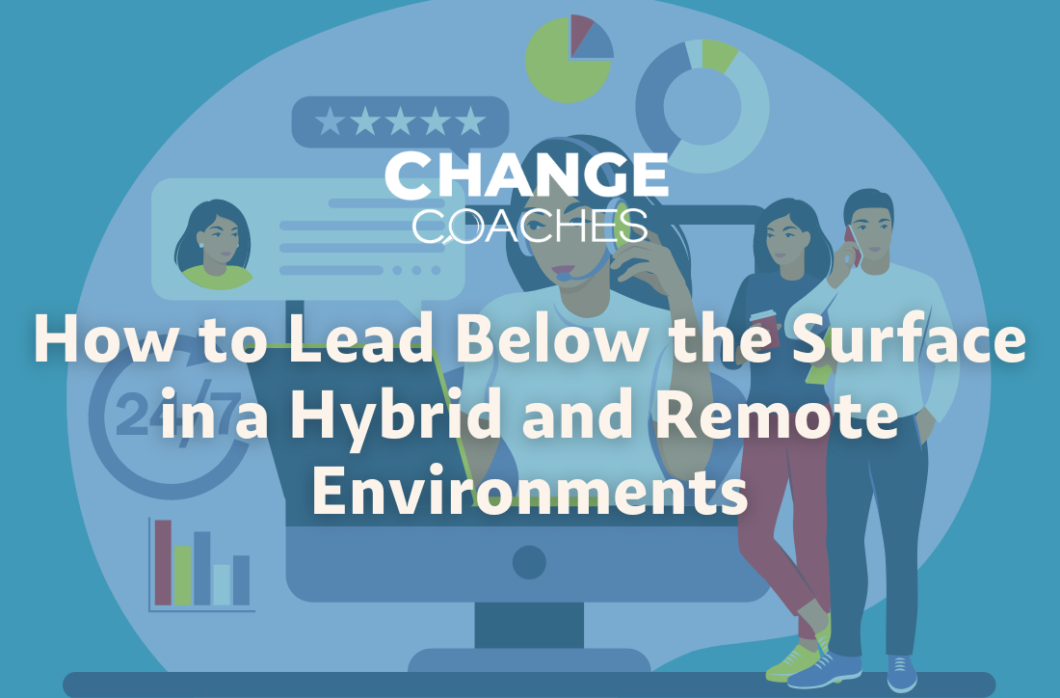How do I lead below the surface in a fully or partially virtual environment?
This is one of the questions I’ve been hearing most often at keynote speaking engagements, and it’s easy to see why. I recently came across a couple of staggering statistics — before COVID-19, fewer than 6% of Americans worked primarily from home but that number ballooned to 35%+ during the pandemic as nearly every employee that could work from home at that time did so. It’s safe to say that we are all still figuring it out.
Although many of us don’t like to admit it, there are some downsides to working remotely. Working from home can be physically and socially isolating. It’s taught us to do our jobs more independently. We no longer have as many little opportunities throughout the day to check in with each other and see how our colleagues or direct reports are doing. Our chances to observe, do a gut-check, and start a discussion in the moment have been severely diminished. What’s really interesting is that despite these cultural challenges, the workforce is unequivocally demanding more work-from-home options. In 2020, companies were forced to create more flexible arrangements and trust their teams to get their work done. There are clearly aspects of remote and hybrid work that are better for us as human beings.
In truth, building strong below the surface connections with employees was a challenge for most leaders even before the pandemic. It goes against the dominant leadership standard that many of us (myself included) were taught in business school and early professional experiences. Instead of speed, meritocracy, “facetime,” and high energy, below the surface leaders value relatability, equity, awareness, and loyalty (REAL Leadership). And now we have to live out those new values via Zoom, Slack, and the other virtual channels we work in.
So, with all this in mind, I have a few questions for you: how do you think the dominant leadership standard shows up in your organization today? What shifts have you made in the transition to a hybrid environment? Keep those questions in mind as we review what the data says and explore ways to get below the surface in the new world of work together.
The Great Work from Home Experiment
We’ve had some time to feel out fully remote and hybrid work environments, try out new ways to manage projects and communicate, and start to envision what a healthy culture of belonging might look like in this evolving environment. Along with our own lived experiences over the past two years, we have new data on how these adjustments have played out for the workforce in general.
We know that productivity largely stays the same or improves when employees work remotely. We also know that communication is critical: companies that provided vague or minimal communication about post-pandemic work arrangements caused concern or anxiety for nearly half of their employees. While it seems that people are enjoying a bit more freedom, disconnecting too much has negative effects. Knowing what we know now, it’s time to ask ourselves again: what does a healthy culture of belonging look like in today’s hybrid workplace? I’ll give you a hint: it goes far beyond productivity in itself.
Getting Below the Surface in Virtual Environments
As with in-person work environments, uncovering your organization’s culture in the virtual workplace begins with identifying where the dominant leadership standard still has a hold on your behaviors and relationships. The next step is reworking those norms with below the surface values and practices.
Use these prompts to dig a bit deeper and discover some ways to infuse more belonging into your virtual workplace:
- How might the dominant leadership standard be dictating your inherent expectations around virtual meetings? Do you send out meeting materials in advance, or do you expect people to “think on their feet?” Are you judging people based on whether they have their cameras on or not? Is the leader expected to talk the most and “steer” the meeting, or do you ever take a round-robin approach?
- As a leader, where are your opportunities for person-to-person (P2P) and person-to-belonging (P2B) listening? That is, when can you practice active listening in a one-on-one setting, creating a genuine connection, and seeking to understand? When can you observe how individual employees interact as part of a group? How can you tell if someone really feels they belong?
- Are you strategically managing your time in the office? Is your company forcing people to come into the office a certain number of days a week or are you strategically earmarking office time for below the surface interactions? Do your employees dread or look forward to coming to the office because they have a purpose to do so? Are you creating a space for REAL connection?
As you start to explore these questions, write down what comes up and where you don’t have enough information. That should be enough to give you some ideas on where to get started. You can also download my free checklist for Leading Below the Surface in a hybrid environment, which I just updated with new criteria.
There’s one final thought I want to leave you with: every organization is at a different place in this transition. The new wave of women and diverse executive leaders are at the leading edge of this change, and they interact differently with employees. They are asking for realness, accountability, and authenticity. They didn’t write the rules, so they are eager to change them. They know their teams are stronger when employees can fully be themselves, and it’s a huge breath of fresh air.
I’m curious; how are you creating a culture of belonging in your hybrid environments? What did I miss? The conversation is still unfolding, and I’d love to hear your thoughts. Let me know what you’re thinking in the comments.

